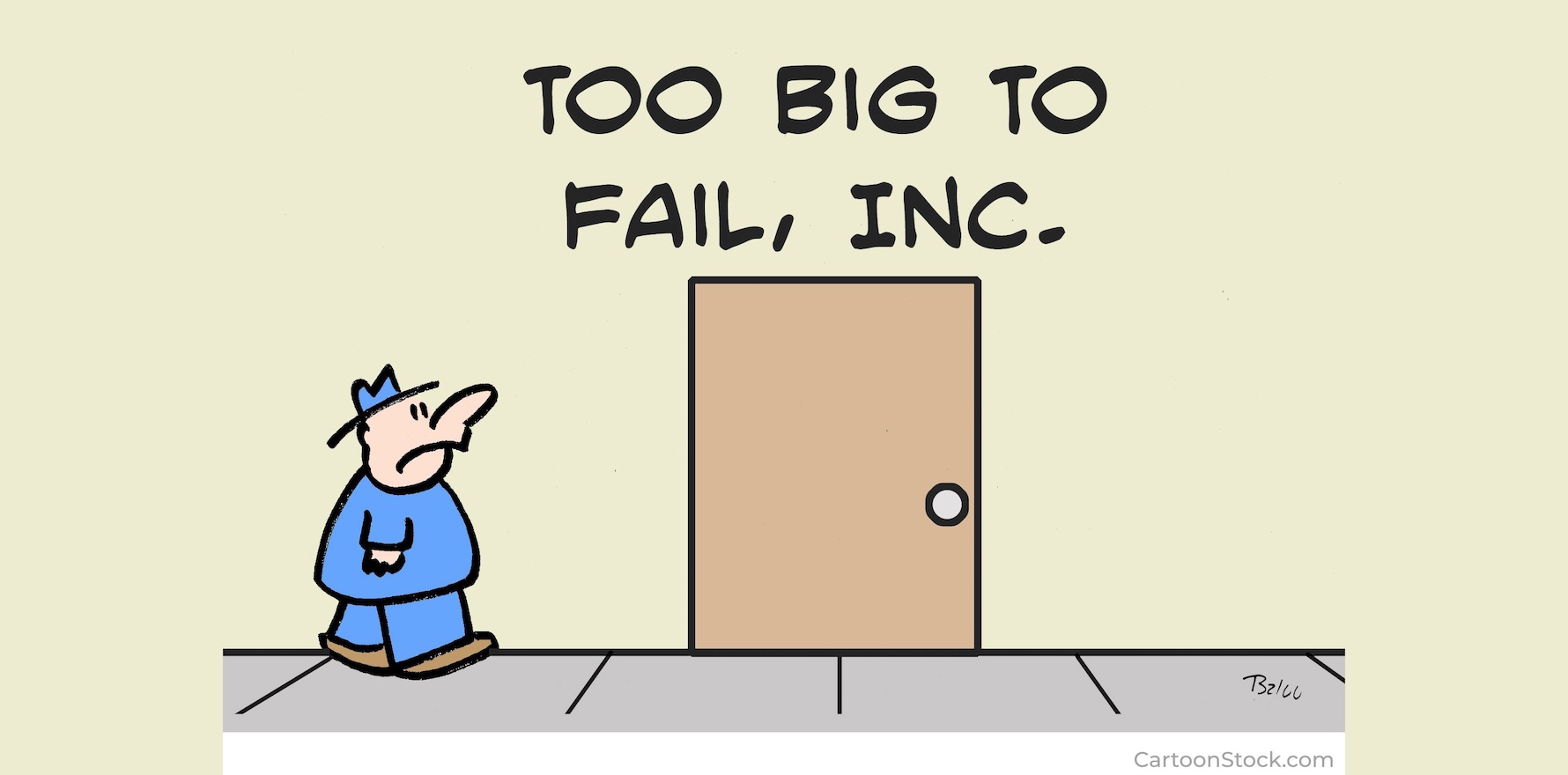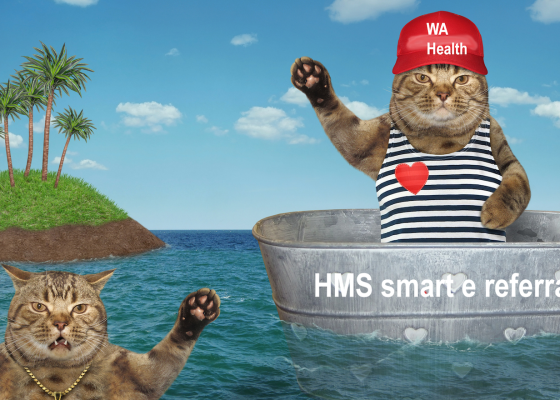Interoperability progress in Australia seems to be splitting into two streams: small innovative web based vendor plays making surprising inroads and, mega infrastructure projects, which while bold in vision, look worryingly expensive and complex
If there was to be a big fat “whoa, look what happened here” warning sign for our energetic and ambitious health system interoperability architects in the Australian Digital Health Agency and the Department of Health and Aged Care, it was this week’s story out of WA about the collapse of a well-intended but complex, expensive and ambitious interoperability project to build a new eReferrals platform.
Many people working in digital health will recognise a lot of components in the failure:
- good background work to understand the issues and lay out an agenda for reform (some of it here);
- a health system struggling with a lot of points of legacy making it hard to know where to start (the state is looking to put in a new EMR as well which would change a lot at the same time);
- a tortured procurement process that took three years to even get the initial tender out (a lot changes in interoperability tech have occurred in that time);
- the involvement of big tech and big consulting throughout the process;
- virtually no transparency in explaining why the winning tender beat out other tenders which seemed more innovative and were pitching at less than half the winning tender price;
- a few murky conspiracy theories around one of the parties that won
And … well, you get the picture.
A compelling aspect of the story which emerged the day after it was written was this comment on a LinkedIn post:
As the architect/developer/inventor/tech support of the original statewide referral (CRS) platform for WA Health, I was stunned to hear the size and cost of this project.
I (with two other devs) built the original in 8 weeks, yes, that’s right, 8 weeks. Sure we worked our tails off but we got there.
So you can understand my pride in knowing that platform we built still works and does its job servicing the WA Health system and all the practitioners that send referrals in, and that as someone as large as these two vendors could not deliver a replacement for such a simple project.
Time and again I saw little local companies who could do the job far better, cheaper and more effectively than the big end of town [but were] completely ignored and never given an opportunity in these types of projects.
I know I sound cranky, I’m just a disappointed taxpayer these days. I spent 19+ years in public health, time and again watching vast amounts of money walk out the door to ‘consultants’ a.k.a snake oil salesman which delivered little if any value and not face repercussions for their conduct.
I remain hopeful that it changes, but I suspect some people treat public health as a cash cow, better patient outcomes be damned.
There’s a lot to unpack in this comment.
Suffice to say, we’ve been here before a lot, and given the huge amount of government digital health money swilling around a hugely ambitious (a good thing) set of mega interoperability infrastructure projects – replatforming the My Health Record for FHIR, the National HIE, Provider Connect, eRequesting, and a lot of satellites to these – we’re entitled to ask, “what’s really different now to when we embarked on the $2 billion wrong left hand turn that became the My Health Record as we know it today?”
Keeping in mind that for the first time in a long time we have a pretty good group of people in government and the ADHA working on interoperability, all pointed mostly the right way for the first time in a long time, with a lot of goodwill and energy, and we have money to do stuff, so we don’t want to be damping their enthusiasm too much at this point of time, here are a few supplementary questions:
- Are we trying to do too much that is too big at the same time?
- Have we exhaustively justified these mega projects in terms of use case ROI to the system, healthcare providers and patients? If so, where have we done this because mostly what we see is big sets of ambitious and well-meaning plans with not a lot of deep use case analysis of ROI or meaningful economic model analysis. Maybe this stuff does exist, but if it does can someone send it to me, please. We should all remember just how good an idea that the My Health Record sounded when it was first mooted. But it wasn’t. Part of the problem was that the centralised technology available when the idea got started was overtaken during the course of the project by much more effective web-based distributed data-sharing technology, but the project had too much momentum to stop because it was so big.
- Specifically, is anyone keeping a day-to-day eye on some of the smaller innovative stuff going on at the coalface that is kicking a lot of interoperability goals already and some of which looks like it could create a bottom-up interoperability revolution whether we build a new MHR and national HIE or not?
- Would it be an okay idea to step back a bit on the big stuff for a second and check the potential ROI of the big versus the small properly and rethink our approach, keeping in mind things like the WA eReferrals fail and our first go at the My Health Record?
For anyone in the ADHA or DoHAC who is reading this and thinks this might be turning into another whinge about them (I’ve done a lot of it over the years), it’s not.
All that smaller and effective coalface innovation going on, is a result of the good work you have done in banging on to everyone about having to move to more modern web-based data-sharing technology, and, of course, the fascinatingly aligned and effective work being done by Sparked (CSIRO) in providing all these innovative vendors with some alignment in clinical coding to get us all there.
At one point it felt like all the threats coming out of DoHAC about the vendors needing to get their act together on web-sharing standards and technology might just be cleverly manipulated and navigated around by the vendor community because of the huge risk and expense of many of them having to turn their tech stacks, and sometimes their business models, upside down.
That we would see a lot of talk of them changing their ways but not a lot of action, unless we actually legislated that if they didn’t do it within a certain timeframe they were going to be out of the system.
There is still some of that going on for sure – you will always have a set of vendors throwing anchors out the back of the transformation bus – but largely things are really starting to move on web-sharing protocols and technology.
The threat is still there and available to DoHAC of course, and the Modernising My Health Record legislation, though nothing as firm and clear as the US government’s 21st Century Cures Act, is a shot across industry’s bow showing that the government is dead serious.
There are probably some other drivers in play here forcing some of our major platform vendors to invest in changing:
- AI is sparking a wave of innovation and investment that has a few of our local big incumbent platform vendor incumbents worried – they should be – so they are deciding to move on AI, and you can’t do that without upgrading your whole tech stack in some way to the cloud;
- Cyber security is a threat that everyone would love to ignore but can’t and the government isn’t. Within two years tech stacks among our vendors will need to be cloud-enabled in some way to meet minimum government standards for operating within a vital national piece of infrastructure, as healthcare is.
- Some of our vendors are now starting to see good competitive opportunity in cloud-based architectures within our healthcare system. Some of our dominant platform vendors have been able to dictate the terms and timing of change over to cloud technology because they own distribution – think our major hospital EMRs, and GP and specialist patient management systems which are gatekeepers of access to these providers – and anyone wanting to plumb into their access needed to specify to non-cloud technology largely. This is all starting to change thankfully with some of these major gatekeepers moving on the cloud, some in a big way.
The long and the short of all of this is that the cloud is finally coming to a provider platform near you in some shape or form. Some vendors aren’t re-architecting from the ground up but building middle ware so their older server-bound applications can talk via the cloud far more effectively.
This is happening with or without the mega interoperability infrastructure projects the ADHA has on the drawing board.
A question now should be asked: what infrastructure and government-backed facilitation is needed to make this bottom-up revolution go faster, in what order of priority. And, if this de novo revolution is better facilitated, might it be that we won’t need some of these big, complex and obviously highly risky mega infrastructure projects like the national HIE? Or, at least not need them in their current “one ring to rule them all” manifestation?
Here’s some of the bottom-up cloud-based revolution I’m referring too that looks like it might have widespread impact.
eReferrals applications and integrations
There are a few cloud-based eReferral applications emerging which are starting to get a lot of interest and traction with various providers, most interestingly, big hospitals.
The applications are generally integrated to our major GP patient management systems and now with the cloud version of Genie, Gentu. This means there is now the opportunity for the thinking person’s hospital manager to have real-time bidirectional and secure communications between their hospital, their specialists, the local GP community, and, wait for it, even the patients involved.
In one way this might be the beginning of the end of secure messaging, an old one-directional server-bound technology which on the one hand is a lot better than paper and fax, which we still have a lot of, but on the other is pretty clunky and hit and miss.
In WA for instance the health department estimates that secure messaging is only effective in about 26% of the GP network.
Our major secure messaging vendor, HealthLink, which still estimates the technology could be around for between 5-10 years (entirely feasible) isn’t sitting back to let its major revenue stream slowly leak away beneath it.
The group, which obviously has a big and loyal customer base across the country, can transition to other technology over time if need be and is also working on its own eReferral, FHIR-aligned web-based applications.
The competition for the web-enabled eReferral space is palpable and it’s all a good thing for everyone in the system.
The government could help all these vendors by prioritising authentication as a piece of useful centralised infrastructure that will grease the wheels of all points of the provider compass (authentication is just one of a lot of things the ADHA has in its plans).
One point that could be greased in this way is big pathology.
OK they’re sort of evil empires so should we really be helping them? Yes, if they can make the system more efficient and deliver better patient experience and outcomes, of course we should.
In terms of eReferrals for pathology we don’t seem to be contemplating the possibility that our existing commercial entities – the pathology companies and the vendors – can potentially do the job better than government.
Our current plan is to run eRequesting for pathology (eReferral) as a part of centralised government infrastructure (it’s one of the ADHA’s mega projects). Is this a good spend of taxpayer money though?
Yes, it’s hard to trust big pathology, but, by partnering with our major specialist patient management system and an innovative eReferral provider they have already established a good means of doing eRequesting: Gentu has a direct web-based integration with Sonic, ACL and Healius and now has Consultmed integrated with Gentu so that eReferral pathway is up and running already.
It means a specialist can eRefer to a hospital or pathology result, and include the patient in the conversation for things like in-patient bookings or specialist bookings.
One problem remains for Sonic, ACL and Healius – patient and provider authentication. They want to own the relationship and transaction of course, but if they can authenticate in real time then the whole series of transactions can take place and a patient and the provider will be able to track and see it all in real time.
Why would we then need to build a government-run centralised eRequesting service?
Major PMSs starting to be cloud-connected
For some time now the GP and specialist patient management systems have been near monopolies on access to their providers, so they got to dictate to a large degree any transition agenda to cloud-based data sharing.
That is all changing now, in part probably because of the government warnings that if they didn’t start changing legislation would demand change, but also because these vendors have worked out that AI and the cloud are inevitable and if they keep resisting they might get gazumped by some smart new entrant building out these technologies.
The long and the short of this trend is that the possibilities for more effective real-time data sharing, both with other providers (including hospitals) and patients, are opening up quickly.
Gentu has a direct integration for web-based sharing with the major pathology groups and in the not-too-distant future the major GP systems are going to connect in that way as well.
This all looks again like the bottom-up is going to work and the government might want to think about getting out of the way by rethinking the idea of them building a centralised eRequesting service for pathology, and simply working out how to better facilitate all these vendors doing it themselves.
Related
A particularly fascinating pilot under way at the moment is an integration between our major GP practice management system, Best Practice, and a big Melbourne hospital instance of Oracle (Cerner).
The biggest interoperability issue by far in our healthcare system is the disconnect between hospitals, GPs and to some degree, specialists.
Now these two major players are toying with some sort of direct integration using, we presume, web protocols – BP uses middleware to talk to the web now – Halo Connect – and Oracle has inbuilt FHIR protocols as a result of the vendor having to comply with web-sharing protocols in the US.
Apparently, BP is talking to EPIC already, or vice versa. And EPIC and NSW Health are thinking about how they will eventually connect to the GP community better, which they must.
Good grief, what is going on here?
Where once the platform vendors saw value in creating data-sharing moats to gate their data to make money, now they’re seeing value in building bridges for far more effective real-time sharing of meaningful patient data. It’s not just goodwill on the part of these vendors, of course. Some of it is, to the extent that where they can help they want to within the constraint of making enough money.
There is something else going on here. The web is coming.
Healthdirect
A quick word on another aspect of the bottom-up interoperability trend, which also probably could do with a little more top-down government help and thinking.
Healthdirect has quickly evolved to offer a very interesting overlay to the whole interoperability picture. It’s not a platform vendor, though. It’s a not-for-profit government-backed agency providing a major service as a provider directory and associated live patient triage, on the phone and online.
It’s most interesting current project we’re calling 222, a service where anyone in Australia can ring or tap into an online process, and ask what to do healthwise and where to go when they don’t need an ambulance. It’s everything else you need in an after-hours or an emergency situation that isn’t 000.
It’s, in effect, a single digital front door for the entire health system.
The problem is, everyone wants their own digital front door, and everyone thinks their region or state has needs that such a centralised system could never have enough definition to deliver.
AI probably puts a big hole in that thinking.
Sure, you’re never going to be perfect from region to region, but just how much does our national healthcare system want to repeat itself, when an idea and system like this, using AI, can avoid massive system rethinking and redundancy, and collect data from patients that would be invaluable for all points of the system to understand better how to design local provider and patient services.
Healthdirect is starting to connect patients in real time to actual services. It’s even providing its own virtual provider services to fill gaps.
Its systems are very relevant to this bottom-up interoperability trend because if the government can somehow get the 222 concept going, they have a real-time overview of what patients need and they can create synergies with all the providers and platform vendors to make it all work a bit better.
The pure cloud vendors
Finally, and with some irony (and conflict), there are a few pure cloud vendors out there who can help the system a lot, but they need to be thought about more carefully, and perhaps helped a bit more by government as well, all in the interest of better innovation and interoperability
My conflict here is that I’m a non-executive director of cloud-first patient management system vendor MediRecords, so taking advantage of that conflict I’m going to describe a couple of dynamics which aren’t good for the system or a pure cloud play like MediRecords.
First, to the irony. You would you think it a bit strange that up until very recently, something like 90% of our software vendors in Australia were not cloud-enabled or architected, whereas in the US, nearly 100% of vendors are. In this day and age of cloud-based everything.
Being a cloud-first vendor in Australia has been a very hard road to tread because when the whole system isn’t cloud, then you have nothing to talk to in your significantly more efficient and thoroughly modern way.
If you want to, you have to build integrations one by one back to older server-bound software platforms, and that’s a business model that’s got a very short life.
If you could wave a magic wand in Australian healthcare, most software platform vendors would be bottom-up cloud-architected, and as long as they all used a common clinical coding protocol and web-sharing standards such as FHIR, everything could largely talk seamlessly in real time to all points of the system and to patients.
You probably then would not need a national HIE or My Health Record largely.
But there are no magic wands in healthcare interoperability – maybe maybe in defence there is, see below. A lot of cloud vendors have been part stranded in the middle ground of having great new modern data-sharing tech but no one to share it with.
This dynamic was not made easier by big government contracts actually specifying the need for applying vendors to talk to old platforms because these platforms were the gateway to major groups of providers such as GPs and specialists.
Cloud providers have had to innovate to survive in what has mostly been a hostile business model environment. It’s all suppressed a lot of important innovation locally.
MediRecords pivoted to where there was a real and immediate need for the sort of service and functionality they could bring to a provider: they underpin a lot of emerging virtual providers that need mobility and the ability to share data across locations seamlessly.
Along with Alcidion, they ended up being the centrepiece of one of the most interesting (and least known) interoperability projects in the country, a contract called JP2060 with the Department of Defence for what is effectively a whole-of-department healthcare system.
It joins GPs to pharmacists to hospitals to insurers to dentists in real time on the cloud and in situ off the cloud when there is no cloud, to ships offshore and so on.
It’s a pure project that points to the future potential of interoperability and the innovation that cloud providers can create. But it was only possible because it was a system specified without the need to talk to all the legacy platforms that exist in most of our healthcare system. It didn’t require integrations to old server-bound GP systems, or public hospitals or Medicare and other payment systems.
The point here is, these are amazing new possibilities for interoperability in the bottom-up revolution we are starting to see that now have proof points the rest of the system should and could be using. But we are still leaving a lot of them on the table because of the admitted need to address the transition of the legacy platforms.
Can we do better in managing this balance in transition between cloud and legacy in the bottom-up trend to interoperability we are seeing?
Innovation in groups like MediRecords, Alcidion, Gentu, Consultmed and Heidi Health, needs to be somehow empowered more than we are currently empowering it.
Mega project vs the bottom-up transition revolution
The bottom-up process with existing vendors and some new innovative cloud-based vendors appears to be well underway.
We need to think more carefully about whether that trajectory and innovation might get us a long way to the big goals that DoHAC and the ADHA are aiming for with their mega projects.
Is there a better middle ground between mega projects and the mostly local vendor-led bottom-up transition dynamic that is going on?




